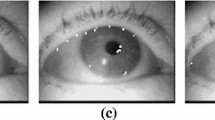Abstract
It is claimed that eye location accuracy is very important to face recognition system performance. In most systems, the eye locations are the most significant facial landmark for the preprocessing step. Eye location estimates can be assessed in absolute terms (e.g., proximity to known eye location) and also in application-specific terms (e.g., performance of a system that employs the location). This paper assesses an automatic commercial eye-finding system in absolute and application-specific terms, using four different face recognition systems and a database of thousands of images. A pilot study on the time-lapse effect suggests that with the time-lapse increasing, the face recognition performance will degrade. Our experiments examine this effect by using a large image dataset, which has a time-lapse up to two years, with 250 subjects and 64300 probes. Experiment results show eye location accuracy is significant to face recognition system performance. Different systems can have different level of sensitivity, and the system using local feature analysis is less sensitive to eye location accuracy. Also all the algorithms tested in this study show that time-dependency exists in face recognition system.
Preview
Unable to display preview. Download preview PDF.
Similar content being viewed by others
References
Hjelmas, E., Wroldsen, J.: Recognizing face from the eyes only. In: Proceedings of the 11th Scandinavian Conference on Image Analysis, Pattern Recognition (1999)
Ryu, Y., Oh, S.: Automatic extraction of eye and mouth fields from a face image using eigenfeatures and multilayer perceptrons. Pattern Recognition 34, 2459–2466 (2001)
Min, J., Flynn, P., Bowyer, K.: Assessment of time dependency in face recognition. IEEE Transactions on Pattern Analysis and Machine Intelligence (2004) (under review)
Yuille, A., Cohen, D., Hallina, P.: Feature extraction from faces using deformable templates. In: IEEE Computer Society Conference on Computer Vision and Pattern Recognition, pp. 104–109 (1989)
Chen, C., Huang, C.: Human face recognition from a single front view. International Journal of Pattern Recognition and Artificial Intelligence 6, 571–593 (1992)
Chow, G., Li, X.: Towards a system for automatic facial feature detection. Pattern Recognition 26, 1739–1755 (1993)
Lam, K., Yan, H.: Locating and extracting the eye in human face images. Pattern Recognition 29, 771–779 (1996)
Huang, J., Wechsler, H.: Eye detection using optimal wavelet packets and radial basis functions (rbfs). International Journal of Pattern Recognition and Artificial Intelligence 13(7), 1009 (1999)
Feng, G., Yuen, P.: Multi cues eye detection on gray intensity image. Pattern Recognition 34, 1033–1046 (2001)
Beveridge, R., Bolme, D., Teixeira, M., Draper, B.: The CSU face identification evaluation system user’s guide: Version 5.0 (May 2003), [Online] Available http://www.cs.colostate.edu/evalfacerec/algorithms/version5/
Available http://www.identix.com
Flynn, P.J., Bowyer, K.W., Phillips, P.J.: Assessment of time dependency in face recognition: An initial study. In: Kittler, J., Nixon, M.S. (eds.) AVBPA 2003. LNCS, vol. 2688, pp. 44–51. Springer, Heidelberg (2003)
Givens, G.H., Beveridge, J.R., Draper, B.A., Bolme, D.: Using a generalized linear mixed model to study the configuration space of a PCA+LDA human face recognition algorithm (April 2003)
Marques, J., Orlans, N., Piszcz, A.: Effects of eye position on eigenface-based face recognition scoring. Technical Paper of Mitre Corp. (October 2003)
Riopka, T., Boult, T.: The eye have it. In: Proc. of ACM SIGMM MultimediaBiometrics Methods and Applications Workshop, Berkeley, CA, pp. 9–16 (2003)
Bolme, D.: Elastic bunch graph matching. Master Thesis, Fort Collins, Colorado (Summer 2003)
Author information
Authors and Affiliations
Editor information
Editors and Affiliations
Rights and permissions
Copyright information
© 2005 Springer-Verlag Berlin Heidelberg
About this paper
Cite this paper
Wang, H., Flynn, P.J. (2005). Experimental Evaluation of Eye Location Accuracies and Time-Lapse Effects on Face Recognition Systems. In: Kanade, T., Jain, A., Ratha, N.K. (eds) Audio- and Video-Based Biometric Person Authentication. AVBPA 2005. Lecture Notes in Computer Science, vol 3546. Springer, Berlin, Heidelberg. https://doi.org/10.1007/11527923_65
Download citation
DOI: https://doi.org/10.1007/11527923_65
Publisher Name: Springer, Berlin, Heidelberg
Print ISBN: 978-3-540-27887-0
Online ISBN: 978-3-540-31638-1
eBook Packages: Computer ScienceComputer Science (R0)




